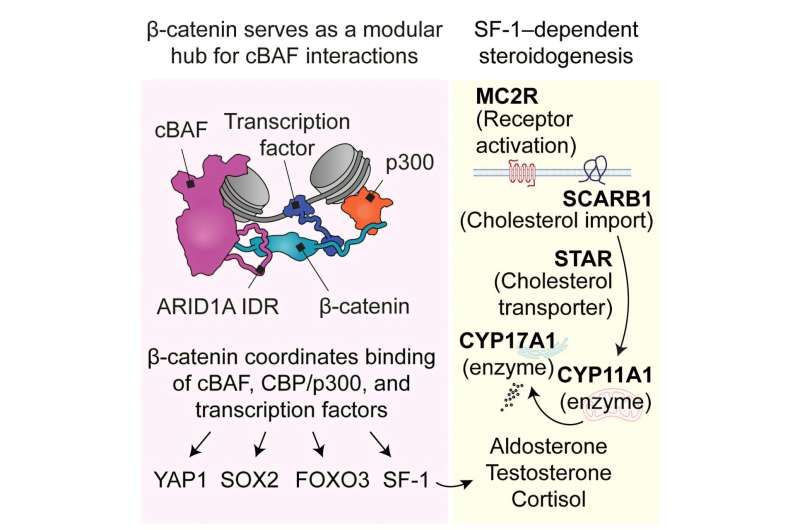Science
Researchers Uncover ‘Bridge’ Protein’s Role in Gene Regulation

A recent study from researchers at Baylor College of Medicine has unveiled a critical mechanism by which disordered proteins regulate gene expression. The research, published on July 21, 2025, in the journal Molecular Cell, highlights the role of a structured protein known as beta-catenin in facilitating interactions among disordered gene regulators. This discovery may reshape our understanding of gene regulation and open doors for new therapeutic targets.
Cells utilize proteins to determine which genes are expressed at any given time. Surprisingly, many of these proteins, crucial for gene regulation, lack a stable structure. Traditionally, scientists believed that these flexible proteins interacted in a diffuse manner, akin to oil droplets merging together. However, the findings from Baylor suggest a more organized interaction involving a ‘bridge’ protein.
The research team, led by Dr. H. Courtney Hodges, an associate professor of molecular and cellular biology, focused on BAF complexes. These complexes are essential for opening DNA, a vital step in preparing genes for expression. Dr. Hodges explained, “The majority of each BAF complex is disordered and acts like a floppy noodle without a structure. Without a fixed shape, it has been difficult to analyze how these disordered regions interact.”
New Insights into Gene Regulation Mechanisms
The study revealed that the disordered regions of the BAF complexes utilize beta-catenin as an adapter. This structured protein acts as a docking station, allowing the flexible regions of other proteins to connect and function effectively. “Beta-catenin links together BAF and other disordered proteins involved in gene regulation,” Dr. Hodges noted.
The research initially targeted the molecular interactions in adrenocortical carcinoma (ACC), a severe adrenal cancer known for producing excessive steroid hormones. The team aimed to understand the molecular mechanisms behind the hormonal imbalances caused by this cancer, which can lead to various symptoms, including depression and immune suppression. Dr. Yuen San Chan, the study’s first author and postdoctoral researcher, stated, “We aimed to understand the root molecular mechanisms driving these hormone disruptions to find a better way to treat this disease.”
The researchers concentrated on how certain factors control the expression of enzymes involved in steroid hormone production within ACC tumors. Their findings indicated that the disordered regions in BAF directly interact with beta-catenin, enabling the BAF complex to locate and open genes that encode steroid enzymes.
Excitingly, the study found that this mechanism is not limited to steroid hormone production. Other significant gene regulators, including proteins involved in stress responses and cancer progression, also depend on beta-catenin for their interactions with BAF.
Implications for Future Research and Therapy
“Our findings challenge the way we think about disorder in biology,” said Dr. Katerina Cermakova, co-corresponding author and assistant professor of biochemistry and molecular pharmacology at Baylor. “Interactions between disordered molecules with structured proteins give rise to a kind of hidden organization.” The research indicates that despite their lack of order, the protein interactions that drive gene expression exhibit a surprising modularity and organization.
While further research is necessary, the implications of this study are significant. The identified factors may serve as potential targets for drug development and new therapeutic strategies. The collaborative effort included various institutions, such as MD Anderson Cancer Center, the Institute of Organic Chemistry and Biochemistry in the Czech Republic, the University of Michigan, and the University of Colorado School of Medicine.
This groundbreaking research paves the way for a deeper understanding of gene expression and its regulation, potentially leading to advancements in treating diseases linked to hormonal imbalances and cancer.
-

 Entertainment3 months ago
Entertainment3 months agoAnn Ming Reflects on ITV’s ‘I Fought the Law’ Drama
-

 Entertainment4 months ago
Entertainment4 months agoKate Garraway Sells £2 Million Home Amid Financial Struggles
-

 Health3 months ago
Health3 months agoKatie Price Faces New Health Concerns After Cancer Symptoms Resurface
-

 Entertainment3 months ago
Entertainment3 months agoCoronation Street’s Carl Webster Faces Trouble with New Affairs
-

 Entertainment3 months ago
Entertainment3 months agoWhere is Tinder Swindler Simon Leviev? Latest Updates Revealed
-

 Entertainment4 months ago
Entertainment4 months agoMarkiplier Addresses AI Controversy During Livestream Response
-

 Science1 month ago
Science1 month agoBrian Cox Addresses Claims of Alien Probe in 3I/ATLAS Discovery
-

 World2 weeks ago
World2 weeks agoBailey Announces Heartbreaking Split from Rebecca After Reunion
-

 Health4 months ago
Health4 months agoCarol Vorderman Reflects on Health Scare and Family Support
-

 Entertainment4 months ago
Entertainment4 months agoKim Cattrall Posts Cryptic Message After HBO’s Sequel Cancellation
-

 Entertainment3 months ago
Entertainment3 months agoOlivia Attwood Opens Up About Fallout with Former Best Friend
-

 Entertainment2 weeks ago
Entertainment2 weeks agoCoronation Street Fans React as Todd Faces Heartbreaking Choice









